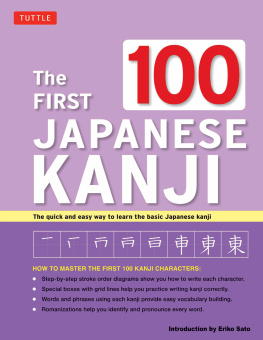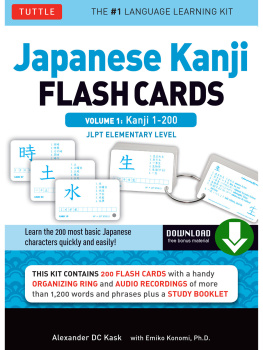Florence Sakade - Guide to Reading and Writing Japanese: , JLPT All Levels (2,136 Japanese Kanji Characters)
Here you can read online Florence Sakade - Guide to Reading and Writing Japanese: , JLPT All Levels (2,136 Japanese Kanji Characters) full text of the book (entire story) in english for free. Download pdf and epub, get meaning, cover and reviews about this ebook. year: 2014, publisher: Tuttle Publishing, genre: Detective and thriller. Description of the work, (preface) as well as reviews are available. Best literature library LitArk.com created for fans of good reading and offers a wide selection of genres:
Romance novel
Science fiction
Adventure
Detective
Science
History
Home and family
Prose
Art
Politics
Computer
Non-fiction
Religion
Business
Children
Humor
Choose a favorite category and find really read worthwhile books. Enjoy immersion in the world of imagination, feel the emotions of the characters or learn something new for yourself, make an fascinating discovery.
- Book:Guide to Reading and Writing Japanese: , JLPT All Levels (2,136 Japanese Kanji Characters)
- Author:
- Publisher:Tuttle Publishing
- Genre:
- Year:2014
- Rating:5 / 5
- Favourites:Add to favourites
- Your mark:
Guide to Reading and Writing Japanese: , JLPT All Levels (2,136 Japanese Kanji Characters): summary, description and annotation
We offer to read an annotation, description, summary or preface (depends on what the author of the book "Guide to Reading and Writing Japanese: , JLPT All Levels (2,136 Japanese Kanji Characters)" wrote himself). If you haven't found the necessary information about the book — write in the comments, we will try to find it.
Students have been reading and writing the Japanese language for centuries, and they build their knowledge most successfully when they rely on a trusted resource. Todays most trustedand readily availableresource is A Guide to Reading and Writing Japanese. This classic, best-selling learning and reference work is the best way to learn kanji and kana, and is now being offered as a fourth, thoroughly revised and up-to-date edition.
Having a knowledge of the full set of General Use characters is the key to mastering everyday Japanese and will allow students to read and write Japanese up to the level of a typical Japanese newspaper with ease and confidence.
Key features of this revised edition include:
Florence Sakade: author's other books
Who wrote Guide to Reading and Writing Japanese: , JLPT All Levels (2,136 Japanese Kanji Characters)? Find out the surname, the name of the author of the book and a list of all author's works by series.















 ICHI, ITSU, hito- , hito(tsu) , one ichigatsu , January ichiban , first, best issatsu , one (book, magazine)
ICHI, ITSU, hito- , hito(tsu) , one ichigatsu , January ichiban , first, best issatsu , one (book, magazine)  NI, futa(tsu) , two nigatsu , February nikagetsu , two months nikai , twice
NI, futa(tsu) , two nigatsu , February nikagetsu , two months nikai , twice  SAN, mi- , mit(tsu) , three sangatsu , March sannin , three people mikka , three days, the third day
SAN, mi- , mit(tsu) , three sangatsu , March sannin , three people mikka , three days, the third day  SHI, yon , yo- , yot(tsu) , yo(tsu) , four shigatsu , April yokka , four days, the fourth day shij , yonj , forty = AP # = JLPT
SHI, yon , yo- , yot(tsu) , yo(tsu) , four shigatsu , April yokka , four days, the fourth day shij , yonj , forty = AP # = JLPT  GO, itsu(tsu) , five gogatsu , May gonin , five people goj , fifty
GO, itsu(tsu) , five gogatsu , May gonin , five people goj , fifty  ROKU, mut(tsu) , mu(tsu) , six rokugatsu , June rokkagetsu , six months rokuj , sixty
ROKU, mut(tsu) , mu(tsu) , six rokugatsu , June rokkagetsu , six months rokuj , sixty  SHICHI, nana(tsu) , nana , seven shichigatsu , July nanakagetsu , seven months shichij , nanaj , seventy
SHICHI, nana(tsu) , nana , seven shichigatsu , July nanakagetsu , seven months shichij , nanaj , seventy  HACHI, yat(tsu) , ya(tsu) , eight hachigatsu , August hachikagetsu , eight months hachij , eighty
HACHI, yat(tsu) , ya(tsu) , eight hachigatsu , August hachikagetsu , eight months hachij , eighty  KY, KU, kokono(tsu) , nine kugatsu , September kuj , kyj , ninety kuji , nine oclock
KY, KU, kokono(tsu) , nine kugatsu , September kuj , kyj , ninety kuji , nine oclock  J, t , ten jgatsu , October tka , ten days, the tenth day jikkai , ten times
J, t , ten jgatsu , October tka , ten days, the tenth day jikkai , ten times  HYAKU, hundred nihyaku , two hundred sanbyaku , three hundred hyakkaten , department store
HYAKU, hundred nihyaku , two hundred sanbyaku , three hundred hyakkaten , department store  SEN, chi , thousand senen , a thousand yen sanzen , three thousand gosen , five thousand
SEN, chi , thousand senen , a thousand yen sanzen , three thousand gosen , five thousand  NICHI, JITSU; hi , day, sun; ~ka , suffix for counting days nichiybi , Sunday sakujitsu , kin , yesterday asahi , morning sun
NICHI, JITSU; hi , day, sun; ~ka , suffix for counting days nichiybi , Sunday sakujitsu , kin , yesterday asahi , morning sun  GETSU, GATSU; tsuki , month, moon getsuybi , Monday raigetsu , next month mikazuki , new moon
GETSU, GATSU; tsuki , month, moon getsuybi , Monday raigetsu , next month mikazuki , new moon  KA; hi , fire kaybi, Tuesday hibachi , charcoal brazier kaji , fire, conflagration
KA; hi , fire kaybi, Tuesday hibachi , charcoal brazier kaji , fire, conflagration  SUI; mizu , water -mizu , flood, inundation suiryoku , water power suihei , sailor
SUI; mizu , water -mizu , flood, inundation suiryoku , water power suihei , sailor  BOKU, MOKU; ki , tree, wood mokuybi , Thursday zaimoku , lumber mokusei , made of wood
BOKU, MOKU; ki , tree, wood mokuybi , Thursday zaimoku , lumber mokusei , made of wood  KIN, KON, gold; kane , money kinybi , Friday o-kane , money kingyo , goldfish
KIN, KON, gold; kane , money kinybi , Friday o-kane , money kingyo , goldfish  DO, TO; tsuchi , earth, soil doybi , Saturday tochi , ground, plot of land dojin , native
DO, TO; tsuchi , earth, soil doybi , Saturday tochi , ground, plot of land dojin , native  NEN; toshi , year rokunensei , sixth-grade pupil toshiyori , old person seinen , youth
NEN; toshi , year rokunensei , sixth-grade pupil toshiyori , old person seinen , youth  SA; hidari , left saha , leftist (political), left wing sasoku , hidarigawa , left side hidarite , left hand
SA; hidari , left saha , leftist (political), left wing sasoku , hidarigawa , left side hidarite , left hand  U, Y; migi , right say , left and right uha , right wing (political) usoku , migigawa , right side
U, Y; migi , right say , left and right uha , right wing (political) usoku , migigawa , right side  J; ue , top, above, on; kami , upper; nobo(ru) , to go up, to go toward Tky; a(geru) , to raise; a(garu) , to rise jry , upstream, upper class kaij , on the sea, maritime kawakami , upstream
J; ue , top, above, on; kami , upper; nobo(ru) , to go up, to go toward Tky; a(geru) , to raise; a(garu) , to rise jry , upstream, upper class kaij , on the sea, maritime kawakami , upstream 